This play is a reflection on the (im)possibility of accepting diversity and the other. The fragmented body of the neoplasm—the fruit of unstable conditions—overcomes barriers, loves and denies itself and others, wanders around, forgetting its profession. It frequently and with pleasure divides, goes through dangerous palpation, questions the possibility of contact with the experience of the other. Poorly brought up but very successful, it invites us to a trans-species transition.
Lorem ipsum dolor sit amet, consectetur adipiscing elit. Fusce at elit quis felis ullamcorper vehicula non in est. Maecenas finibus pharetra justo et faucibus. Nulla eu tortor vel ex volutpat efficitur. Vivamus placerat turpis in aliquet venenatis. Quisque ac lacinia mauris. Nam quis lobortis elit. Vestibulum sagittis nisi sit amet euismod hendrerit. Mauris non sodales odio. Donec efficitur molestie quam, sed lobortis massa vestibulum ut.
Nunc at arcu sodales nisi porta euismod non vel neque. Phasellus at lobortis ante, in suscipit justo. Proin non purus vitae nisi molestie consectetur. Vestibulum volutpat lobortis interdum. Vestibulum pretium ligula lorem, egestas ultricies lectus ultricies ac. Curabitur venenatis vulputate dolor.
The installation begins behind a blue curtain. The curtain provides an opening to a kind of studio. Tables, fixed walls, and two rolling walls are constructed from metal studs and unfinished drywall. Photos of body parts hang in front of the blue fabric curtains. Piles of photos and tracing paper lie carelessly on the tables. The space is always in flux during the exhibition. The artist reorders the layering of information by moving objects around, tracing new images, and putting new images on top of photos.
Two large photographs of a transparent man and woman illustrate human organ systems. Cadaver trays contain similar photos of body parts, and the floor is strewn with other images. Two TV monitors provide yet another layer of information: one monitor displays a live shot of the slide projections being shown as the visitor enters the space, while the other monitor runs a video of slide projections previously shown.
Artist Statement
This installation is an investigation of “other ways of knowing.” The basic idea was to create a space where the participant could suspend his or her relationship to the outside world and allow the physical and non-physical residue of an urgent and obsessive activity to determine the significance of the space… Each element was chosen for its implied reference to an idea or activity to determine the significance of the space…each element was chosen for its implied reference to an idea or activity: blue fabric for its reference to theater, religion, ritual, and performance; steel tables for their reference to the clinical, and the scientific; a model for its reference to transcendence beyond the physical… Photography was chosen as the means of investigation for its capacity to quickly document material with an implied truthfulness. The fact that these images are of plastic organs and that photography has nothing to do with truth creates tension between what is known and what is understood.
The space is meant to suggest the idea of activity itself rather than the idea of a finished product or position. All of the elements of construction and creation have been left visible and nothing has been made permanent. Every item has been fabricated concentrating on its function or implied function within the space, not its existence as object. This sense of transience and residual activity concentrates our experience on the idea of process rather than outcome.
The process of creating this space has been a dance between the tendency to impose and articulate meaning and the ability to allow meaning and significance to exist in a purer form through activity.
Exhibition
Robert Beckman received his BFA in Studio Printmaking from Kent State University. He holds a MFA in Experimental and Traditional Printmaking; Photo / Screen / Electrostatic / Intaglio from Kent State University and has been working as a printmaker and artist for over 30 years.
Beckman is the director of Artists Image Resource (AIR) in Pittsburgh, PA. AIR is an artist-run organization that serves as a printmaking studio, an exhibition venue, and an educational printmaking and project resource for local artists. Beckman has also taught at Carnegie Mellon University and Edinboro University of Pennsylvania.
He has exhibited his work throughout the United States and abroad, including the Pittsburgh Biennial; Silver Eye Photo Gallery, Pittsburgh, PA; Pittsburgh Filmmakers Gallery; Pittsburgh Center for the Arts; Pinnacle Gallery, Rochester, NY; Pratt Graphics Center, Brooklyn, NY; Trumbull Art Gallery, Warren, OH; C.A.G.E Gallery, Cincinnati, OH; and Communale E’Arte Moderna, Bologna, Italy, among others.






